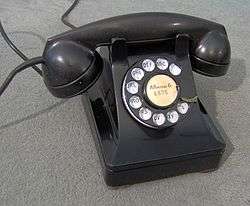Henry Dreyfuss

.jpg)


Henry Dreyfuss (/ˈdraɪfəs/; March 2, 1904 – October 5, 1972) was an American industrial designer. Dreyfuss and his firm received world-wide recognition for numerous designs for a wide spectrum of consumer and commercial products, including their long-time association with the Western Electric company and the Bell System for designing telephones from the 1930s through the 1960s. His design philosophy was based on applied common sense and scientific principles and resulted in significant contributions to human factor analysis and consumer research.
Career
Dreyfuss was a native of Brooklyn, New York. As one of the celebrity industrial designers of the 1930s and 1940s, Dreyfuss dramatically improved the look, feel, and usability of dozens of consumer products. As opposed to Raymond Loewy and other contemporaries, Dreyfuss was not a stylist: he applied common sense and a scientific approach to design problems. His work both popularized the field for public consumption, and made significant contributions to the underlying fields of ergonomics, anthropometrics and human factors. Until 1920 Dreyfuss studied as an apprentice to theatrical designer Norman Bel Geddes, his later competitor, and opened his own office in 1929 for theatrical and industrial design activities. It was an immediate and long-lasting commercial success. As of 2005 his firm continues to operate as Henry Dreyfuss Associates in Ann Arbor, Michigan, with corporate clients.
Designs
Dreyfuss and his associates designed some of the most ubiquitous and iconic products of twentieth century America. Among them:
- Western Electric 302 tabletop telephone for Bell Laboratories (produced 1936–1954)
- Hoover model 150 vacuum cleaner (1936)
- Classic Westclox Big Ben alarm clock (1939 - present)
- New York Central Railroad's streamlined Mercury train, both locomotive and passenger cars (1936)
- NYC Hudson locomotive for the Twentieth Century Limited (1938)
- Popular Democracity model city of the future at the 1939 New York World's Fair at the Trylon and Perisphere
- Styled John Deere Model A and Model B tractors (1938)
- Wahl-Eversharp Skyline fountain pen (1940)
- Royal Typewriter Company's Quiet DeLuxe (late 1940s)
- Western Electric 500 Bell System desk and wall telephones (1949 - 1972)
- Two American steamships, S.S. Independence and S.S. Constitution for American Export Lines (1951–2)
- Honeywell T87 "the Round" circular wall thermostat (1953 - present)
- Spherical Hoover model 82 Constellation vacuum cleaner which floated on an air cushion of its own exhaust (1954)
- Hoover model 65 convertible vacuum cleaner (1957)
- Princess telephone (1959)
- Bankers Trust Building at 280 Park Avenue in Manhattan, New York City, with Emery Roth & Sons (1963)[1]
- Model 1500 10 digit touchtone (1963)
- Trimline telephone (1965 - present)
- Model 2500 12 digit touchtone (1968 - present)
- Polaroid SX-70 Land camera (1972)
Later life
In 1955, Dreyfuss wrote Designing for People. A window into Dreyfuss's career as an industrial designer, the book illustrated his ethical and aesthetic principles, included design case studies, many anecdotes, and an explanation of his "Joe" and "Josephine" anthropometric charts. In 1960 he published The Measure of Man, a collection of ergonomic reference charts providing designers precise specifications for product designs. In 1965, Dreyfuss became the first President of the Industrial Designers Society of America (IDSA). In 1969, Dreyfuss retired from the firm he founded,[2] but continued serving many of the companies he worked with as board member and consultant. In 1972 Dreyfuss published The Symbol Sourcebook, A Comprehensive Guide to International Graphic Symbols. This visual database of over 20,000 symbols continues to provide a standard for Industrial Designers around the world.
Death
On October 5, 1972, Henry Dreyfuss and his terminally ill wife and partner Doris Marks Dreyfuss took their lives together. Dreyfuss is survived by a daughter, eight grandchildren, and twelve great grandchildren.
References
Notes
- ↑ White, Norval & Willensky, Elliot with Leadon, Fran (2010). AIA Guide to New York City (5th ed.). New York: Oxford University Press. ISBN 9780195383867., p.317
- ↑ Henry Dreyfuss Associates | People | Collection of Smithsonian Cooper-Hewitt, National Design Museum
Bibliography
- Dreyfuss, Henry. Symbol Sourcebook: An Authoritative Guide to International Graphic Symbols. New York: John Wiley & Sons. 1984. ISBN 0-471-28872-1
- Dreyfuss, Henry. Designing for People. Allworth Press; illustrated edition, 2003. ISBN 1-58115-312-0
- Flinchum, Russell. Henry Dreyfuss, Industrial Designer: The Man in the Brown Suit. Rizzoli, 1997. ISBN 0-8478-2010-6
- Innes, Christopher. Designing Modern America: Broadway to Main Street. Yale University Press, 2005. ISBN 0-300-10804-4
External links
| Wikimedia Commons has media related to Henry Dreyfuss. |
- Henry Dreyfuss Associates website
- Video on Dreyfuss's design for Honeywell thermostat and for his Bell Telephone, at Wikimedia Commons
|